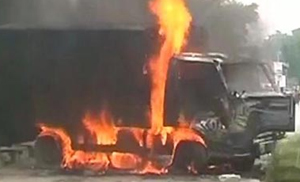 Azamgarh (UP), Jul 19: Former MLA and BSP leader Sarvesh Singh Seepu and another person was today shot dead by unidentified assailants, leading to violence in the district with protestors clashing with police and a man being killed allegedly in police firing.
Azamgarh (UP), Jul 19: Former MLA and BSP leader Sarvesh Singh Seepu and another person was today shot dead by unidentified assailants, leading to violence in the district with protestors clashing with police and a man being killed allegedly in police firing.
Six others were injured in the violence.
The tension erupted after 35-year-old Seepu and Narad Rai (40), who came to him for some work, were shot dead by unidentified men in front of his house, police said.
As soon as the news of the murder spread, hundreds of Seepu's supporters attacked Jiyanpur police station and snatched rifles from policemen, indulged in brick-batting and tried to set police station afire, IG law and order, R K Vishwakarma said in Lucknow.
The angry mob also torched two 'Vajra' vehicles and six motorcycles, he said, adding that police had to open fire to control the unruly mob and attempts are being made to control the situation.
Vishwakarma said besides former MLA, two persons were killed and added that it was not confirmed whether one death took place in police firing.
The incident appeared to be fall out of an old enmity, he said, adding that a search operation has been launched in neighbouring Mau, Jaunpur, Ambekdanaragar districts to nab the assailants.
Seepu was a Samajwadi Party MLA from Sagari seat till 2012. He then joined BSP and had contested the last Assembly elections on BSP ticket from Sadar seat here.
Seepu's father Rampyare Singh was a cabinet minister in previous Mulayam Singh Yadav government.
Meanwhile, condemning the killing of Sarvesh Singh, Leader of Opposition in Legislative Assembly and a senior BSP leader Swami Prasad Maurya in Lucknow demanded that immediate steps be taken to check the "goonda raj" in the state.
"When people's representatives are not safe what can be said about the common man," Maurya said, adding that Sarvesh Singh, who had joined the BSP in 2012, was provided security but it was withdrawn by the SP government.
"This shows government's apathetic attitude," Maurya said.
Alleging that the SP government was not serious on the issue of law and order, he said that murder of people's representative amounted to murder of democracy.
On police firing on Singh's supporters, Maurya said it showed the apathy and laxity on part of government and administration.
Maurya demanded an inquiry into the police firing and strict action against those guilty.
BJP and Congress have also condemned the murder of Sarvesh Singh and expressed apprehension that it could be a fallout of political conspiracy.
"It is most unfortunate that a former Samajwadi Party MLA was shot dead under the SP government," state unit president of the BJP, Laxmikant Bajpai said.
"I have my doubts that it could be a part of political conspiracy. Sarvesh Singh had left SP and joined the BSP and perhaps because of this his security threats were not taken seriously by the police," Bajpai said, adding that police acted in an irresponsible manner by opening fire on his (Sarvesh's) supporters and the government would have to reply for it.
Akhilesh Singh of Congress said that the incident was an example of the high morales of criminal elements in the state where there is no law and order.
Akhilesh Singh said that only someone who enjoyed the patronage of the government could dare to open fire at a former MLA and his security guard. "No one is safe in the state", he added.






Comments
Add new comment